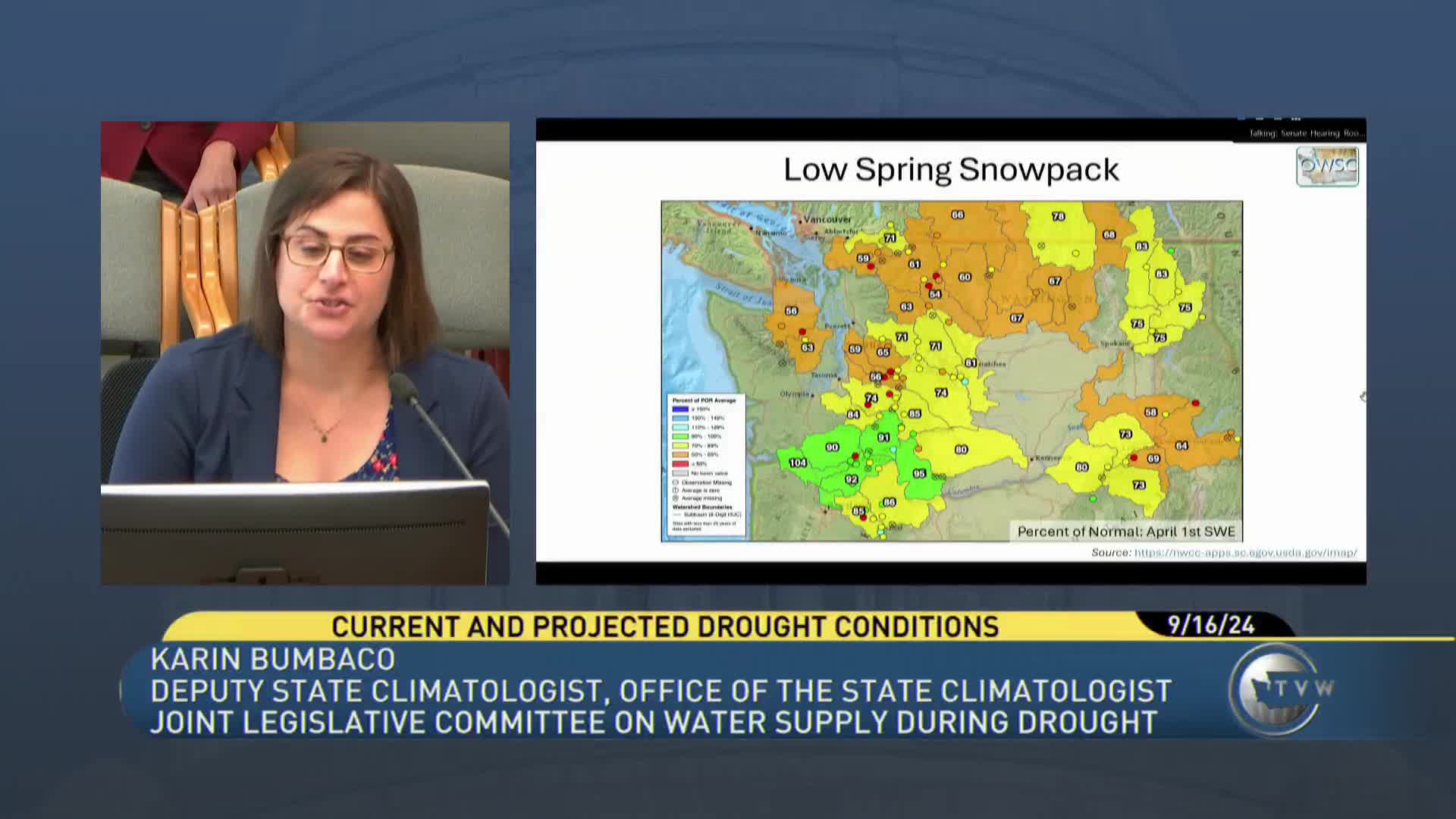Washington faces severe drought as snowpack dwindles
September 16, 2024 | Joint Legislative Committee on Water Supply During Drought, Joint, Work Groups & Task Forces, Legislative Sessions, Washington
This article was created by AI summarizing key points discussed. AI makes mistakes, so for full details and context, please refer to the video of the full meeting. Please report any errors so we can fix them. Report an error »

In a recent government meeting, officials discussed the current drought conditions in Washington state, highlighting significant concerns regarding snowpack levels and temperature anomalies. As of April 1, 2024, many watersheds in the state reported below-normal snowpack, attributed primarily to warmer-than-average winter temperatures and a 10% deficit in winter precipitation. This situation has led to several basins meeting hydrologic criteria for drought.
The meeting revealed that July 2024 was particularly notable, with temperatures averaging 4.1 degrees Fahrenheit above normal, marking it the second warmest July on record in over 130 years. While the summer overall ranked as the 13th warmest, it was cooler than the previous three summers, suggesting that conditions could have been worse without some cooler periods.
Precipitation patterns varied significantly across the state. Eastern Washington experienced less than 50% of normal summer precipitation, exacerbating drought conditions, while Western Washington saw near-normal to above-normal rainfall due to atmospheric river events in early June and mid-August. The U.S. Drought Monitor indicated some improvement in Western Washington, but conditions in the east continued to worsen.
Streamflow levels were reported as much below normal during the summer months, with a slight recovery noted in mid-August due to rainfall. However, recent data indicated that streamflows had not yet returned to normal levels. Soil moisture levels also reflected dryness, particularly in Southeastern Washington, although improvements were observed in Western regions following recent rains.
Looking ahead, the meeting addressed the potential impacts of a developing weak La Niña, which historically correlates with wetter and cooler winters in Washington. Seasonal forecasts suggest a higher likelihood of above-normal precipitation this fall and winter, which could alleviate some drought concerns if consistent.
Officials emphasized the importance of monitoring snowpack levels in the coming winter, as they are critical for determining drought status in the spring. Despite the challenges posed by current conditions, there is cautious optimism regarding future precipitation patterns and their potential to mitigate drought impacts.
The meeting revealed that July 2024 was particularly notable, with temperatures averaging 4.1 degrees Fahrenheit above normal, marking it the second warmest July on record in over 130 years. While the summer overall ranked as the 13th warmest, it was cooler than the previous three summers, suggesting that conditions could have been worse without some cooler periods.
Precipitation patterns varied significantly across the state. Eastern Washington experienced less than 50% of normal summer precipitation, exacerbating drought conditions, while Western Washington saw near-normal to above-normal rainfall due to atmospheric river events in early June and mid-August. The U.S. Drought Monitor indicated some improvement in Western Washington, but conditions in the east continued to worsen.
Streamflow levels were reported as much below normal during the summer months, with a slight recovery noted in mid-August due to rainfall. However, recent data indicated that streamflows had not yet returned to normal levels. Soil moisture levels also reflected dryness, particularly in Southeastern Washington, although improvements were observed in Western regions following recent rains.
Looking ahead, the meeting addressed the potential impacts of a developing weak La Niña, which historically correlates with wetter and cooler winters in Washington. Seasonal forecasts suggest a higher likelihood of above-normal precipitation this fall and winter, which could alleviate some drought concerns if consistent.
Officials emphasized the importance of monitoring snowpack levels in the coming winter, as they are critical for determining drought status in the spring. Despite the challenges posed by current conditions, there is cautious optimism regarding future precipitation patterns and their potential to mitigate drought impacts.
View full meeting
This article is based on a recent meeting—watch the full video and explore the complete transcript for deeper insights into the discussion.
View full meeting
